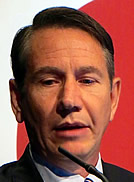Nivolumab is associated with a high response rate in patients with classical Hodgkin lymphoma
After the impressive results with checkpoint inhibitors in solid tumors, programmed death-1 (PD-1) inhibition also comes at age in the treatment of hematological malignancies. Updated results of the phase I CA209-039 study, investigating the PD-1 inhibitor nivolumab in the treatment of patients with relapsed or refractory classical Hodgkin lymphoma (R/R cHL), demonstrate a high rate of durable responses. Moreover, promising progression-free (PFS) and overall survival (OS) data were presented with a consistent and manageable safety profile, underlining the feasibility of long-term nivolumab use in patients with cHL.
The (PD-1) immune checkpoint pathway regulates T-cell–mediated antitumor immune responses in solid tumors and hematologic malignancies. Nivolumab is a fully human IgG4 PD-1-blocking monoclonal antibody with demonstrated efficacy in a broad range of tumors. In an earlier publication of the CA209-039 study, nivolumab was shown to be well tolerated with an impressive overall response rate (ORR) of 87%. At that time however, important questions were raised regarding the durability and depth of the observed responses. During ASH 2015, the clinical course and post-treatment outcomes from an extended follow-up of these patients were presented, shedding more light on these questions.
The R/R cHL patients in the dose expansion part of the study at hand, received nivolumab 3 mg/kg at week 1 and 4, and then every 2 weeks for up to 2 years. The treatment was discontinued in case of intolerance to the treatment or when progressive disease was observed. Responding patients discontinued therapy after they achieved a confirmed complete response (CR) or 16 weeks after an unconfirmed CR. In case of a partial response (PR) or disease stabilization, the treatment was continued for up to 2 years. Patients who discontinued treatment with an ongoing CR, PR, or SD could be retreated if they had confirmed progressive disease within 1 year after nivolumab discontinuation. The primary objective of the study was safety, with antitumor activity as the key secondary endpoint.
In total, 23 patients with R/R cHL were treated in the dose expansion part of the study. The median age was 35 years and the median number of previous therapies was 5 (ranging from 2 to 15). Of the 23 patients, 18 patients previously received brentuximab vedotin (78%). At the time of the presented analysis, 20 out of 23 patients had completed the therapy and treatment was ongoing in 3 patients. The overall response rate in the study was 87% (20/23). Five patients achieved a CR, 15 patients had a PR, and in the 3 non-responders disease-stabilization was observed. Interestingly, the responses were shown to be durable, with the median duration of response (DoR) not being reached after a median follow-up of 101 weeks. A schematic representation of the DoR in all patients is depicted in slide 2 of the ‘Keyslides’ attached to this article. The median PFS and OS were also not reached after the 101-week follow-up. After 1 year, the OS rate was 91% and after 18 months, this rate had slightly dropped to 83%.
Responses were maintained in 2 patients after discontinuing nivolumab for more than 40 weeks and in 1 patient after stopping due to toxicity. Eight patients with durable responses received nivolumab for more than 1 year, including 7 patients who have been in response for over 18 months. Interestingly, 1 patient with an initial CR experienced a relapse 43 weeks after treatment was discontinued. This patient was retreated with nivolumab and achieved a second response (CR). Of the 10 remaining responders, 4 patients eventually progressed, 1 patient discontinued treatment due to toxicity without progressive disease, and 5 patients discontinued nivolumab to undergo a stem cell transplant after achieving a remission. Overall, 3 patients discontinued nivolumab due to an adverse events (1 patient with grade 2 peripheral neuropathy, 1 patient with grade 3 myelodysplastic syndrome and 1 patient with grade 3 pancreatitis). Grade 1 or 2 immune-related adverse events occurred in 4 out of 10 patients and resolved without treatment in 2 patients. Of note, the incidence of immune-related adverse events did not increase with time on treatment.
In summary, the updated results of this phase I study confirm the high rate of durable responses with nivolumab in cHL patients. Moreover, promising PFS and OS data were presented, with a consistent and manageable safety profile, underlining the feasibility of long-term nivolumab use in patients with cHL. As such, these data support the further evaluation of nivolumab in cHL patients in the larger, ongoing phase II CHECKMATE-205 study.
Reference
Ansell S, Armand P, Timmerman J, et al. Nivolumab in Patients (Pts) with Relapsed or Refractory Classical Hodgkin Lymphoma (R/R cHL): Clinical Outcomes from Extended Follow-up of a Phase 1 Study (CA209-039). Presented at Ash 2015; Abstract #583.


